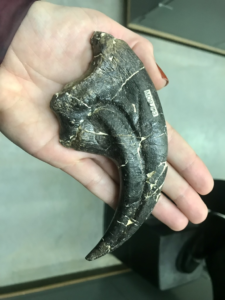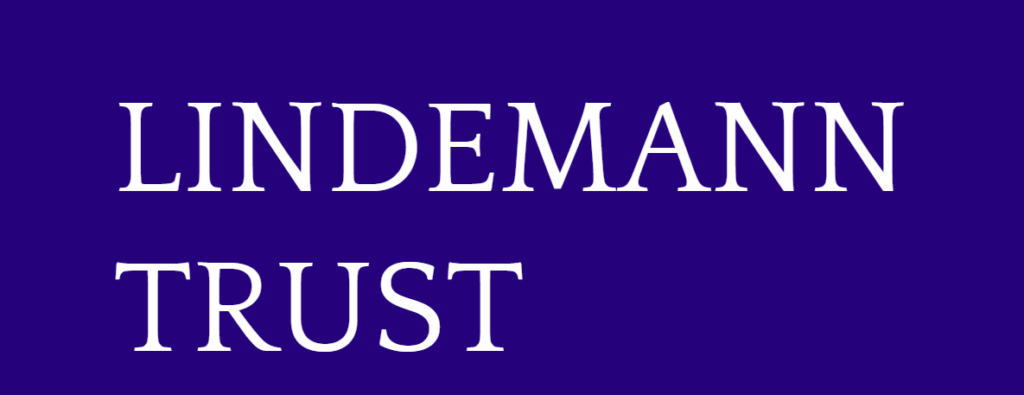Alumni Stories
Martha Gibson spent 2 years at West Virginia University from April 2022 to March 2024. She credits her Lindemann Fellowship as having been instrumental in helping with her next career move. 
“From April 2024, I will be working for PetroStrat Ltd in Conwy, Wales, as a Palynologist Staff Stratigrapher. PetroStrat reached out to offer me this position after seeing me present at the AASP-The Palynological Society meeting at the University of Kentucky in June 2023. My Lindemann Trust Fellowship at West Virginia University, and the opportunities being based in the USA has afforded me, have been essential in helping me seek employment.”
This picture is Martha holding a 150-million-year-old dinosaur claw belonging to “Big Al”, the famous Allosaurus from the Walking with Dinosaurs documentary The Ballad of Big Al, kept behind the scenes at the Museum of the Rockies in Montana. Martha explains that this dinosaur is one of the main reasons she decided to become a palaeontologist and “holding a piece of him was a full circle moment”.
Nelson Lam spent his Fellowship at the Scripps Research Institute in 2020.
During his year, he completed two projects: the first on the enantioselective C(sp3)–H arylation of native thioether substrates, and the second on the site-selective C(sp2)–H alkenylation of azine substrates. Nelson also co-wrote, and successfully secured, two National Institute of Health (NIH R01) research grants totalling over $4 million (US) in research funding, and is currently co-authoring an authoritative book on the field of C–H activation. He has been intimately involved in the National Science Foundation Centre for Selective C–H Functionalisation, having participated in several centre-wide events and initiatives.
Nelson has recently been a regular presenter at our Cambridge Outreach events, where his experiments using the water from a boiled red cabbage to test how acidic something is have been a real hit with the children!
Chandrima Ganguly, 2018 Fellow, who went to Dartmouth, New Hampshire, explains how her Fellowship offered her so much more than she had originally anticipated.
“The Lindemann fellowship has given me an opportunity to explore not just new research interests that I am now working on and trying to learn more about, but also to understand a different way of life. I feel that I have left Hanover, New Hampshire with an interest beyond Standard Model physics and its methods of detection in Cosmology, many friends, and a new-found interest in trail running.”
 Spending a year at Harvard, 2020 Fellow, Alexander Dear, has determined how to design an optimal drug delivery protocol for the suppression of protein aggregation, taking into account inherent fluctuations in the underlying chemical reaction processes.
Spending a year at Harvard, 2020 Fellow, Alexander Dear, has determined how to design an optimal drug delivery protocol for the suppression of protein aggregation, taking into account inherent fluctuations in the underlying chemical reaction processes.
He found dramatically different optimal protocols depending on the mode of action of the inhibitor being delivered, and radically different sensitivities of these protocols to stochastic fluctuations. He also demonstrated how to update the treatment strategy for a specific protein aggregation reaction.
2020 Fellow, David Wakerley, spent a year at Stanford University.
“As a testament to what the fellowship has done for me, my company www.Dioxycle.com was recently selected to be supported by a Breakthrough Energy Fellowship, which was founded by Bill Gates. This will provide us with funding to build CO2-converting technologies. I’m sure I wouldn’t be in this position if it wasn’t for the initial Lindemann post doc!”
Felix Flicker, a theoretical physicist, spent a year as a Lindemann Trust fellow at U. C. Berkeley in 2015.

His work was on the newly emerging field of topological materials, in which many foundational results had been obtained in Berkeley. During his stay the 2016 Nobel Prize for Physics was awarded to three researchers working in this field. His work during this period covered a range of topics, from ‘time quasilattices’ which act as if they live in two dimensions of time, to the discovery of ‘excitonium’ [Science 358, 1314 (2017)], to the identification of emergent ‘magnetic monopoles’ which resemble the north pole of a magnet without the south [Nature 571, 234 (2019)] (see also his talk on this subject at the Royal Institution).
After his Lindemann Trust fellowship Felix took up the Astor Junior Research Fellowship at New College, Oxford, before joining Cardiff University as a lecturer in 2020. He has recently written a book introducing his subject, condensed matter physics, to a general audience: The Magick of Matter in the UK (Profile) and The Magick of Physics in the US (Simon and Schuster). A short video introducing some of the ideas in the book can be found on our outreach page, and you can read more in this interview with the Guardian.
 Jutta Toscano undertook her Fellowship at Boulder, Colorado, in 2019, and credits her time there with more than just the development of her specific research project.
Jutta Toscano undertook her Fellowship at Boulder, Colorado, in 2019, and credits her time there with more than just the development of her specific research project.
“[My Fellowship] has been extremely formative and gratifying. I have had the opportunity to be involved in several projects and, as a result, I have learned a lot about ultrafast lasers, molecular spectroscopy and dynamics, buffer gas cooling and breath analysis. This freedom to explore science has been mainly thanks to the partial independence that the Lindemann fellowship has afforded me, for which I am truly grateful. This would not have been possible had I been tied to a specific project through a grant. I have also enjoyed living in the US and learning about the multidimensional American culture. I have met wonderful people and benefited from numerous conversations with people that have different points of view and hold different beliefs from mine. Finally, I have had the chance to experience the incredible natural landscapes that are hidden around the mountains in Colorado, which I will certainly miss when I leave.”
Matthew Horton, 2017 Fellow, spent a year at Berkeley, California.
“I have used this time to foster more collaborations and relationships, which is something that feels ever more important in the current political climate. I am heartened that, despite much uncertainty among my colleagues both [in the US] and back home, the spirit of international scientific collaboration seems stronger than ever.”
Steve Quinn used advanced single-molecule microscopy and spectroscopy techniques to explore the structure and function of membrane proteins implicated in human disease. Steve performed his 2016 – 2017 Lindemann Fellowship in the Department of Chemistry at MIT. He is now a Lecturer in Biophysics and leads the Biological Nanosystems Laboratory at the University of York.
During his time at MIT, Steve developed advanced biochemical procedures to produce a series of controllable and tuneable model membrane nanodiscs. These structures, only a few tens of nanometers in size, consisted of a small lipid bilayer held together by a protein belt and served two purposes. First, they allowed single cancer-related membrane proteins to be embedded within the bilayer and second, they offered a near-physiological environment from which to infer their structural dynamics and behaviour. Steve then applied a molecular nanoruler technique known as “single-molecule Förster resonance energy transfer” or “smFRET” to identify conformational switching of the proteins in response to a variety of ligands. You can read more about his work here:
- Single-Molecule Fluorescence Detection of the Epidermal Gowth Factor Receptor in Membrane Discs. Biochemistry, 58, 286-294 (2019).
- Ligand-induced transmembrane conformational coupling in monomeric EGFR.Nature Communications. 13, 3709 (2022).
Steve’s group now interrogates the dynamics and interactions of biomolecules implicated in a variety of disease pathways, including neurodegenerative disorders such as Alzheimer’s disease. He said, “The Lindemann Trust Fellowship gave me a valuable opportunity to engage with highly interdisciplinary research teams, learn new biochemistry skills, and drive forward a research project related to human health. Many of the tools and techniques I learned are now in regular use by my own PhD students.”
Astrophysicist, Martin Laming, spent his Fellowship at the Smithsonian Astrophysical Observatory in Cambridge, Massachusetts, from 1989 to 1990, and went on to work at the US Naval Research Laboratory, where he has stayed ever since.
“The Lindemann Fellowship changed my life”, he says. He credits his success to a timely change of research field and to learning how to communicate with different audiences, something he feels was not perhaps emphasised enough during his time at university. “In the real world, when you’re responsible for justifying your existence, raising money and making sure people understand what you’re doing, being able to give talks and communicate to a wide variety of audiences becomes very important.”

